Filling the gap between PC/104 and EBX
Mar 9, 2002 — by Rick Lehrbaum — from the LinuxDevices Archive — 9 viewsUpdated: Mar 19, 2014 — A growing number of companies offer small SBCs that fit within a size gap between the PC/104 (13 sq. in.) and EBX (46 sq. in.) form-factors. Unfortunately, no dominant standard for such “half-EBX” sized boards has emerged, so each supplier's product family tends to implement a unique approach and few are interchangeable with each… other.
Being 1.5 to 2 times the size of PC/104 modules, and given the availability these days of highly integrated system-on-chip processors as well as highly integrated peripheral controllers, SBCs in this size range have sufficient board space to fit just about all the functions a small Embedded Linux based system is likely to require. In addition, many of these SBCs can also be expanded using PC/104 or PC/104-Plus modules, or via PCMCIA or CompactFlash cards. Another benefit of the larger size of these SBCs, in comparison with PC/104 form-factor SBCs, is that they can more readily accommodate the size and heat dissipation requirements of high performance CPUs — in case your application needs it.
Although no formal standardization effort for this size domain (in the gap between PC/104 and EBX) is currently underway either on the part of the PC/104 Consortium or elsewhere, several candidate form-factors appear ready and willing to serve this niche . . .
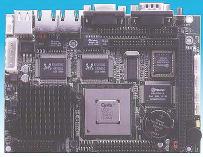
Advantech's “Half-Biscuit” — called a 3.5-inch disk drive form-factor by its originator, this family of 5.7 x 4 in. form-factor SBCs typically contains all of the functions of a full PC system. Versions are available from Advantech based on 486, National Geode, and Transmeta Crusoe processors (details here). The form-factor is also reportedly supported by several other Taiwanese manufacturers including Aaeon, Axiom, ICP, and Lanner. Unlike the Ampro and JUMPtec-Adastra alternatives, the Half-Biscuit provides “real world” I/O and power connectors, and does not require a baseboard for use in a system.

Ampro's EnCore — Each compact (100 x 145 mm; 3.9 x 5.7 in.) EnCore module includes a processor, system and Flash storage memory, plus a set of standardized peripheral interfaces (IDE, floppy, Ethernet, serial, parallel, USB, and sound), while some also provide graphics controllers for CRTs and flat panels. The modules interface with customer-developed “custom logic boards” via a combination of PCI bus and standardized I/O signals, without regard to processor architecture. Since all EnCore modules have consistent feature-sets, physical dimensions, and interface connector locations, a single custom logic board design can support multiple processor architectures simply by exchanging Encore modules. The modules implement the PC/104-Plus PCI bus, but not the ISA bus. Ampro currently supports the EnCore form-factor with 486, Pentium, Pentium III, MIPS, and PowerPC processors, making the form-factor an interesting candidate for a processor architecture independent module standard (details here).
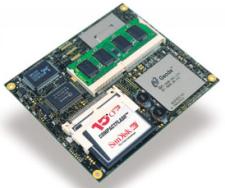
Kontron's ETX COMs — ETX COMs (computer-on-modules) are highly integrated and compact (3.7 x 4.4 in.) SBCs that can be used in a design application much like an integrated circuit component. Each ETX COM integrates core CPU and memory functionality, the common I/O of a PC/AT (serial, parallel, etc.), USB, audio, graphics, and Ethernet. All I/O signals as well as a full implementation of ISA and PCI buses are mapped to four high density, low profile connectors on the bottom side of the module. JUMPtec-Adastra launched the standard before being aquired by Kontron. Kontron sells ETX COMs with National Geode, Intel Pentium, and Intel Pentium III processors (details here). At least two other companies now support the ETX form-factor, including Advantech and TMC Technology. Additionally, Kontron recently announced plans for an upgrade to its ETX format based on PCI Express, called ETXexpress.
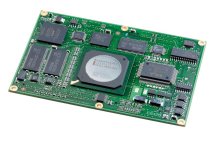
Kontron's E2Brain — Kontron says it hopes its E2Brain specification can do for RISC boards what standards such as PC/104, EBX, EPIC, ETX, and COM Express have done for x86. The company has shipped at least one Linux-friendly E2Brain board, and published the E2Brain specification. It hopes to establish a consortium of OEMs and board vendors around the specification, it says.
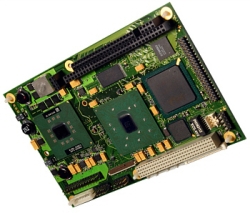
Kontron's SpeedMOPS — Kontron is positioning its 5.8 x 3.8 inch (22 sq. in.) SpeedMOPS form-factor as a “stretched” version of PC/104-Plus that approximately matches the footprint of a 3.25-inch disk drive. Kontron says that by positioning the processor outside the PC/104-Plus stack envelope, the SpeedMOPS format enables optimal cooling of high-performance CPUs. The company has said that it is negotiating for an extension to the PC/104 specification to accomodate the speedMOPS form-factor for high-performance applications.
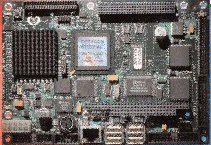
PC/104 Consortium's EPIC standard — Five SBC vendors launched EPIC (the “Embedded Platform for Industrial Computing” standard) in March 2004. The EPIC spec defines a 4.5 x 6.5 inch (29.4 sq. in.) board, and allows I/O connections to be implemented as either pin-headers or PC-style (“real world”) connectors. The standard provides specific I/O zones to implement functions such as Ethernet, serial ports, digital and analog I/O, video, wireless, and various application-specific interfaces. EPIC was subsequently adopted by the PC/104 Consortium, and has been picking up vendors ever since.

VITA's ProcessorPMC (PrPMC) — VITA's PrPMC standard generalizes the PCI Mezzanine Card (PMC) specification (which was developed for CompactPCI board expansion) so that the PMC form-factor can be used to implement CPU modules. PrPMC modules provide board-to-board connectors which provide PCI and I/O signals to a baseboard, and also have a “front bezel” for optional external I/O connectors. The highly compact (2.9 x 6.0 in.) modules can operate both as host and slave modules on an appropriately configured PCI bus. A number of vendors have announced PrPMC SBC modules which support operation under Embedded Linux, including RadiSys and Technobox. One notable disadvantage of PrPMC is that its dimensions are highly constrains due the requirements of being a mezzanine bus.
Story navigation . . .
- Part 1: About this guide
- Part 2: A Linux-oriented Intro to Embeddable Single Board Computers
- Part 3: PC/104 and PC/104-Plus SBCs
- Part 4: EBX SBCs
- Part 5: Filling the gap between PC/104 and EBX
- Part 6: Tiny SBCs for Embedded Linux based projects
- Part 7: Mini-ITX madness
- Part 6: Tiny SBCs for Embedded Linux based projects
This article was originally published on LinuxDevices.com and has been donated to the open source community by QuinStreet Inc. Please visit LinuxToday.com for up-to-date news and articles about Linux and open source.